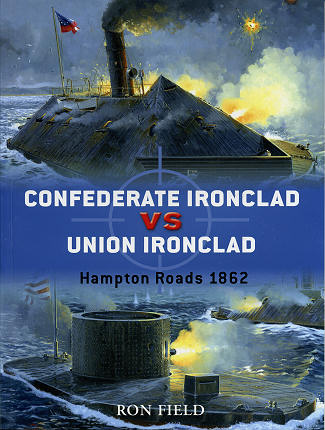 Osprey's
Duel series is now up to 14 editions with this one concentrating on the Civil
War and the first clash of ironclad vessels. Both ships were pretty much new
technology in terms of design. Both of them were put into battle with less than
perfect engines and some rather major design faults. Both of them missed
opportunities to sink the other vessel for a number of reasons and the the
result of their combat was inconclusive, though strategically, one could give
the contest to the Union side as it did prevent the Confederate ship from
completing its designed mission.
Osprey's
Duel series is now up to 14 editions with this one concentrating on the Civil
War and the first clash of ironclad vessels. Both ships were pretty much new
technology in terms of design. Both of them were put into battle with less than
perfect engines and some rather major design faults. Both of them missed
opportunities to sink the other vessel for a number of reasons and the the
result of their combat was inconclusive, though strategically, one could give
the contest to the Union side as it did prevent the Confederate ship from
completing its designed mission.
As you'd expect, much of this book covers the background,
design and development of the CSS Virginia and the USS Monitor. The CSS Virginia
was built up from a reclaimed Union ship, the USS Merrimack and often books and
other publications will refer to the Confederate ship by this name. The Virginia
was basically a ship that was a make do sort of vessel. It had several design
flaws, a possibly fatal one being that the completed ship sat too high in the
water and so the relatively unprotected area below the plating was accessible by
gunfire. Fortunately for the Confederates, the Union USS Monitor, a most
unseaworthy and unhealthy vessel that nearly sank twice on the way to the battle
scene, had guns that would not depress far enough to hit that area and also had
an untrained gun crew that scattered shot all over the Virginia. There were
other aspects of the battle that kept either side from sinking its opponent, but
I'll leave that to the book to explain. Wouldn't want to give away the whole
story.
The Duel series follows a well planned and somewhat set
design. There is a section on the design and development of the weapons,
technical specifications, a look at the combatants involved and the strategic
situation at the time of the event. Then the book gets into the combat itself
and once that has been described goes into a statistical analysis of the event.
This is followed by how the event may have altered future design and
development. In this case, it covers some of the other ironclad vs ironclad
battles, few though these actually were. Finally, there is a section on how the
type was further developed, including post war use.
All of this is accompanied by an excellent selection of
period illustrations, paintings and photographs. There are also several modern
illustrations and artwork to provide details and a further look at the vessels
and men in action. It all makes for an excellent read and one that I am
confident you will enjoy as well. Highly recommended.
December 2008
For more on the complete line of Osprey books,
visit www.ospreypublishing.com. In the US, it is
Osprey Direct at 44-02 23rd St, Suite 219, Long Island City, NY 11101., where you can
get a catalogue of available books.
If you would like your product reviewed fairly and quickly, please contact
me or see other details in the Note to
Contributors.
 Osprey's
Duel series is now up to 14 editions with this one concentrating on the Civil
War and the first clash of ironclad vessels. Both ships were pretty much new
technology in terms of design. Both of them were put into battle with less than
perfect engines and some rather major design faults. Both of them missed
opportunities to sink the other vessel for a number of reasons and the the
result of their combat was inconclusive, though strategically, one could give
the contest to the Union side as it did prevent the Confederate ship from
completing its designed mission.
Osprey's
Duel series is now up to 14 editions with this one concentrating on the Civil
War and the first clash of ironclad vessels. Both ships were pretty much new
technology in terms of design. Both of them were put into battle with less than
perfect engines and some rather major design faults. Both of them missed
opportunities to sink the other vessel for a number of reasons and the the
result of their combat was inconclusive, though strategically, one could give
the contest to the Union side as it did prevent the Confederate ship from
completing its designed mission.